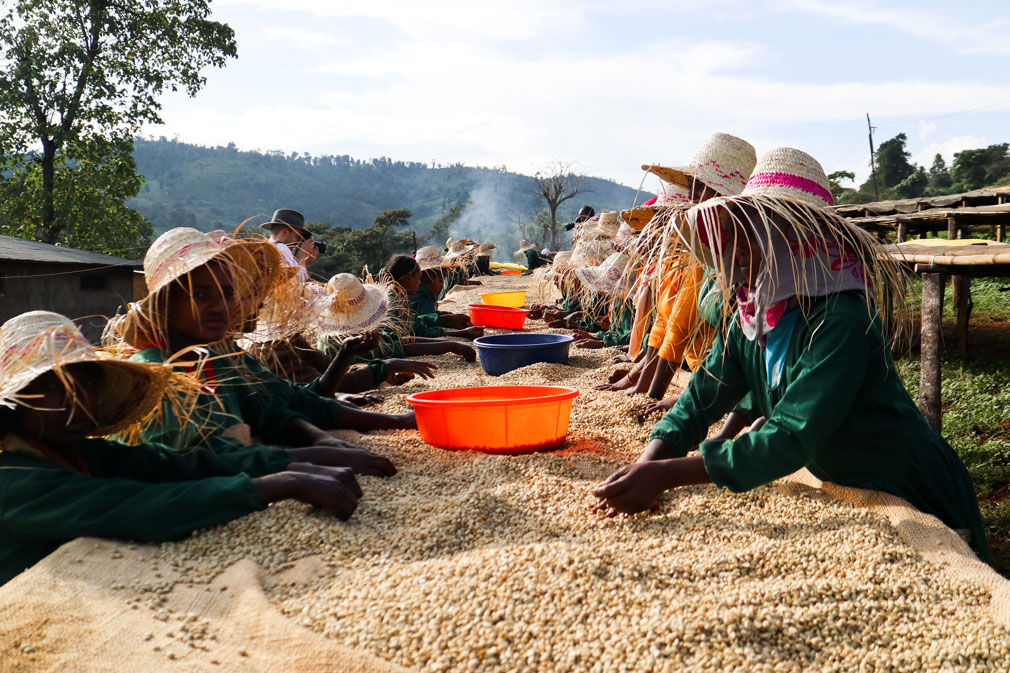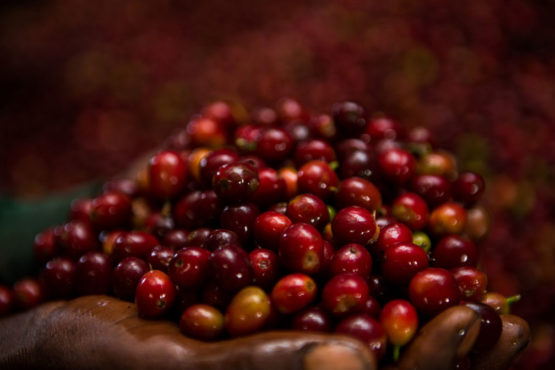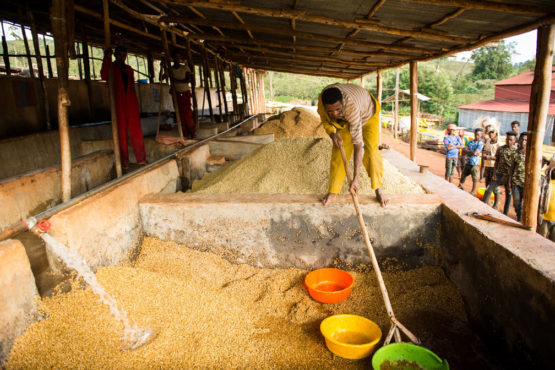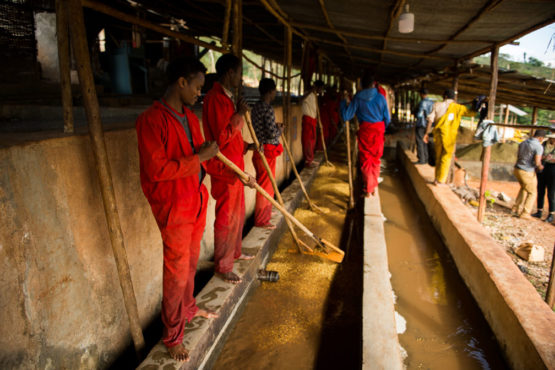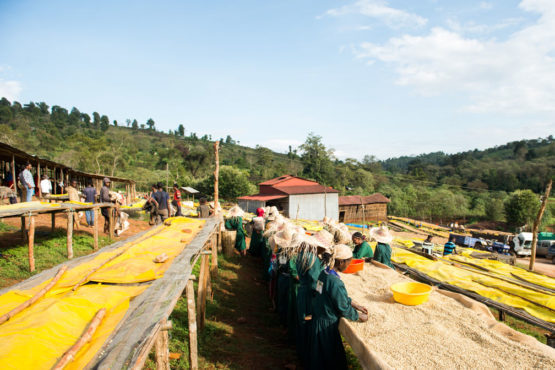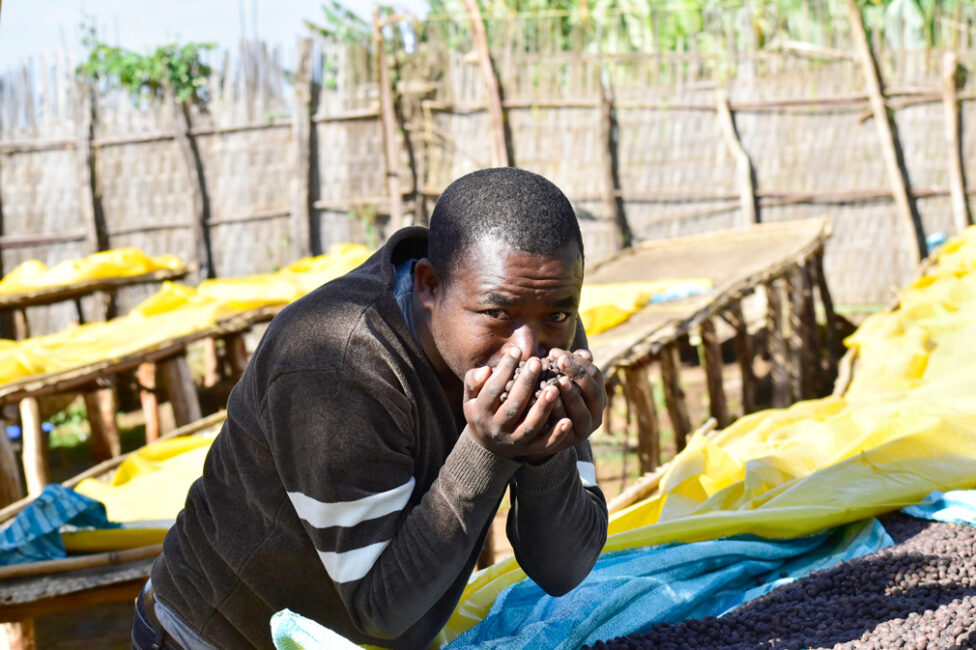Moredocofe
Beautifully balanced and floral with a honey sweetness, and notes of jasmine, rose, raspberry and plum.
Moredocofe (pronounced “Moor’d-coff”) originates from the Shakisso ‘woreda’ (administrative district) in the Guji zone, in Ethiopia’s Southern Oromia State, about 200 miles from the Kenyan border.
Moredocofe stands for ‘Mora Mora River Valley Development Organic Coffee’ and was founded in 2002 by Haile (“pronounced Ha-lé” ) Gebre and his wife Dimbelal Endale. They own two farms and a washing station under the Moredocofe umbrella, and also work with 2,000 small-holders (or ‘out-growers’ as they are commonly referred to in Ethiopia) to produce high quality, organic coffee.
In total Haile and Dimbelal own around 500 hectares of land in Shakisso—which is very unusual in Ethiopia—and have planted 420 hectares with semi-forest coffee. Haile is passionate about many things and cares deeply about the environment; to this end he has dedicated 70 hectares to pure forest, and taken a very careful and considered approach to farming coffee.
In addition to their farm, Moredocofe is also dedicated to working with small producers to produce exceptional quality coffee, and to face the challenges of a delicate ecosystem, poor farming education, and limited access to quality and sustainability initiatives by addressing these issues front on.
Haile’s philosophy revolves around growing with his producing partners and doing this in a sustainable way. He believes very enthusiastically that his success can only come from the success of his local community in Shakiso, his out-growers, and his customers, and has implemented many social programs to help develop these communities. For example, he has a nursery for propagating coffee seedlings, and he has made this large enough to share coffee seedlings with all of his out-growers free of charge. He sees this as an incentive for his local community to continue to plant and rejuvenate their coffee plantations, and also an incentive for them to grow. Haile has also provided the farming community with extensive education on cherry selection, harvesting, and best agricultural practises. He has a sample roaster and gives producers the opportunity to cup their coffees and better understand the feedback around taste.
Haile has also helped build a primary school (and has a second in the works) for his local community, providing care and education to the children of his out-grower partners.
Haile is passionate about organic farming, and believes that this is the only truly sustainable way to produce coffee. One of his core beliefs is that what you take out of the earth—like fruit from the trees—you should put back into the earth in equal measure. To achieve this Haile has a program to compost organic material, including the pulp from coffee cherries, and encourages his out-grower partners to follow this program also.
ABOUT THE GUJI REGION
The Guji zone was established as a unique production area in 2002. It is located in the Southern portion of Sidamo, and is named after the Oromo people; a tribe with a long, proud history in coffee production.
Coffees from Guji were previously classified as ‘Sidamo’ (a very wide geographical classification encompassing much of central-south Ethopia), however more recently they have been separated from this classification and recognised for their unique and distinctive cup profiles. This distinctiveness is driven by the unique combination of elements in this production area, including high altitudes, rich, fertile soil, and exceptional heirloom varieties.
Guji is bordered on the south and west by Borena, on the north by Gedeo and Sidama, and on the east by Bale and the Somali Region. Coffees that are classified as ‘Gujis’, originate from the ‘woreda’ (administrative regions) of Adoola Redi, Uraga, Kercha, Bule Hora, and Shakisso, which is where this lot is from.
Most communities in the region still live rurally and make a living from farming. Coffee remains the main cash crop for most families in the Guji region, who grow coffee alongside food for consumption, and other cash crops such as the Ethiopian banana.
VARIETY
This coffee is a mix of varieties that we have refer to as “heirloom varieties”. This is a term that is all encompassing and used by many actors in the coffee industry to generally categorise Ethiopian coffee varieties that are from native forest origins. Whilst this describes many of the varieties found in Ethiopia, it is also a bit simplistic, and does not recognise varieties that have been specifically developed and widely distributed by the Jimma Agricultural Research Centre (JARC).
In the Sidamo growing region, there are four “Specialty Group varieties” that have been released by JARC. These are called Angafa, Faye, Koti and Odicha. There are also native or “landrace” varieties in the region that were originally selected from the forest and have been propagated in the Sidamo region for decades. There are five popular ones that all have been named after indigenous trees in the area: they are Bedessa, Kudhumi, Mique, Sawe and Walichu. There is little documentation on the history of these varieties, and it is hard to know if they represent single varieties or a wider group of varieties, however it is widely accepted that they play a major role in the quality of the coffee from this region, with a distinctive floral and citric cup profile.
PROCESSING
This coffee was processed at Moredocofe washing station which is located at 1,820m above sea level. Coffee cherries are delivered daily to the station from Moredocofe’s farm, as well as their 300 out-grower partners, who each have around 2–3 hectares of land located at 1,800—1,900m above sea level in the immediate region.
This particular lot was processed using the washed method. Haile oversees every step of the processing at the mill. This coffee is classified as Grade 1, indicating that a lot of effort has been put into the selection, grading and drying to ensure the very highest quality coffee is produced.
As coffees are delivered to the mill they are meticulously hand-sorted prior to processing to remove unripe, overripe, or damaged fruit, in order to enhance the quality and sweetness of the cup. The coffee cherries are then pulped to remove the fruit and skin, and then graded by weight; heavier beans are superior quality and deliver a sweeter cup. After grading, the parchment-covered coffee is soaked in tanks of clean water for 48–72 hours to remove the mucilage (sticky covering) by allowing it to ferment and detach from the coffee.
The coffee is then re-washed and graded again by density in washing channels and soaked in clean water for 12–24 hours. The coffee is then dried for 12–15 days on African drying beds, firstly under cover and then subsequently in the sun. Whilst drying, the coffee is carefully hand-sorted, and any defects are removed. It is also turned regularly to ensure that it dries evenly and consistently. At midday, the coffee is covered to protect it from full sun. It is also covered overnight to prevent damage from morning dew. Once the coffee is dry it is rested in parchment until it is ready for export.
WHY WE LOVE IT
It is so special to have a coffee that is traceable back to a single farm in Ethiopia, and to work with such a visionary producer. Haile’s commitment to his workers, his community, his out-growers, and to specialty coffee and the environment is awe-inspiring and we feel very lucky to work with him and to represent his coffees.
Haile’s attention to detail in harvesting and processing can be tasted in the cup. In the cup, it is sweet and complex, with a floral aroma and notes of raspberry, plum, rose and jasmine.
